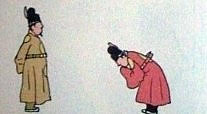Hangul: Joseon subservience to Ming China
« previous post | next post »
[This is a guest post by Bob Ramsey]

In Joseon Korea, state agencies enthusiastically accepted their satellite position vis-à-vis Ming China. In fact, when King Sejong (1397-1450) revealed his new, non-Chinese writing system, the bureaucracy issued, in 1444, a blistering denunciation bordering on accusations of blasphemy:
“Our court, since the times of our founders and ancestors, has with utmost sincerity served the Great. We have uniformly honored Chinese institutions. But now, at this time of identical culture and identical standards, we create the Vernacular Script. We observe and attend this with alarm… If these graphs should flow into China, and if people there should adversely criticize them, how could we be without shame, considering our Service to the Great and our emulation of Chinese civilization!
“Although from ancient times customs and local usages have differed within the Nine Lands, there has never been a case of separately making a script based on local speech. Only the likes of the Mongols, Japanese, and Tibetans have their own graphs. But these are the matters of barbarians, and not worth talking about. It has been traditionally said, ‘Change the barbarians using Chinese ways; we have never heard of changing toward barbarianism.’ … In matters of culture, literary and material, and in ritual and music, we have rather imitated Chinese civilization. To now separately make the Vernacular Script is to abandon China and identify ourselves with barbarians. This would be what they call forsaking the perfume of storax for the dungball pushed by the beetle. How could this fail to have great implications for our civilization!”
“Service to the Great” was virtually a national motto, after all. But… Sejong’s new alphabet was “a dungball pushed by the beetle”?
Here, it’s important to remember that the Korean king was not an absolute monarch like China’s emperor. Sejong was subject to censorship by several governmental organs, and this rebuke from his College of Assembled Worthies was not considered out of line.
And, in fact, the bureaucracy prevailed. Classical Chinese continued to be the official writing system of Korea up until the middle of the 19th century. Hangul would have to wait to become a Korean icon.
Selected readings
- "A Dartmouth grad's contribution to the development of Hangul" (6/25/15)
- "His Coffeeness" (4/10/14) — in the comments
- "The pragmatic and innovative Choe Sejin — 15th-16th c. Korean phonetician, translator, and interpreter" (4/21/22)
- "The esthetics of East Asian writing" (4/7/12)
Jim Breen said,
May 14, 2022 @ 11:24 pm
"Only the likes of the Mongols, Japanese, and Tibetans have their own graphs. But these are the matters of barbarians, and not worth talking about."
Says it all, really.
Victor Mair said,
May 15, 2022 @ 1:15 pm
Bob Ramsey added this after he sent in the main body of the post:
I have to point out that I deleted the Tanguts and Jurchens from the list of barbarians (Mongols, Japanese, and Tibetans) because the text was too long–and also because I suspected most people would be unfamiliar with those names! Also, as I'm sure you know, Choe Malli's document was much, much longer.
Immediately following the text of the memorial, the Sejong Sillok records a dialogue that took place between Sejong and his opponents. The text of what's written down is a bit garbled; you have to imagine that the scribes must have been bewildered–after all, they couldn't possibly have understood all the technicalities of what was said! But Sejong's better logic and mastery of the issues shine through nevertheless.
Jim Unger said,
May 15, 2022 @ 2:53 pm
I recall hearing a lecture on the Mongol bureaucracy in which it was pointed out that the Mongols distrusted Han persons and therefore used (pre-modern) Uighurs throughout their empire, including Korea, as interpreters. Apparently, some Uighur families remained in Korean after the rise of the Ming and rose to positions of power. It seems reasonable to think that they were a source of knowledge about pHags-pa script—its structure and purpose. That would certainly make sense in light of Ledyard's theories about the origins of hankul.
KIRINPUTRA said,
May 16, 2022 @ 10:33 am
Pardon my ignorance, but can a scan of Choe Malli's denunciation (or parts of it) be found online?
SAMUEL Robert Ramsey said,
May 16, 2022 @ 4:07 pm
KIRINPUTRA, Wikipedia has an English-language translation (if that's what you're looking for): https://en.wikipedia.org/wiki/Choe_Manri
The translation here is serviceable, but it isn't the most felicitous. Gari Ledyard's version is vastly superior, but you'd have to go to his Berkeley dissertation ("The Korean Language Reform of 1446") to find it.
But this brings up a point that I find particularly frustrating. Apparently because Ledyard was not Korean, Koreans have avoided his translations in favor of their own English versions that Koreans have produced. It's maddening. Why can't the authorities at the "Hangeul Museum" and elsewhere realize that Gari Ledyard's English-language texts are so much better than the English they've come up with themselves? Gari was such a masterful translator and stylist! As in so many areas of culture, this kind of nationalism has not served them well.
KIRINPUTRA said,
May 16, 2022 @ 10:32 pm
Thank you, Prof. Ramsey. I was looking for a scan of the original document — to file away for show-and-tell, but also b/c modern text type-ups tend to be somewhat unfaithful to premodern texts. I found a couple of readable pages of what (to my inexperienced eye) seems like the original, or a premodern copy of it:
https://m.cafe.daum.net/truepicture/Qt7/1166294?listURI=%2Ftruepicture%2FQt7
I'll look for Mr. Ledyard's dissertation. That aspect of Korean nationalism is unfortunate. (But it seems — superficially, at least — to be entwined with their success in achieving "mid-sized independence" in a part of the world where others have failed.)